At Quiver Management, we believe in the virtues of creating a strong company vision. We’ve seen the benefits it brings to clients who establish a clear direction for the business. This is no more relevant than in the turbulent times that we face today, as Brexit looms, the political landscape remains volatile and uncertainty prevails.
A good company vision however, should be underpinned by a clear understanding of the financial drivers of the business. Mark Nicholls of Tectona Partnership goes on to explain how understanding the company finances can help shape more astute and financially sound decisions that support growth.
Understanding the numbers

Here at Tectona, we work with lots of small businesses and are regularly called upon to explain what the numbers actually mean to the people running them. They are often focused on only one piece of the picture – growing their business by selling more – to the exclusion of other things that they should be considering first.
We have all heard the phrase: Turnover is Vanity, Profit is Sanity and to that you could add “Cash is King”.
Every business needs a healthy cash position to survive and grow. Cash needs to be closely monitored and the reasons for any change on the cash position clearly understood.
So, if we accept that cash is more critical than either turnover or profit, this vanity strategy of “doing more of the same” is usually very ill-advised – particularly in the sort of uncertain times we are experiencing right now.
Tectona has a very simple way of helping you identify if your business is “growth ready”. We rank your key drivers in order of their cash generating ability – and simply selling more of the same is rarely in the top three. Interesting – and a crucial exercise if you are thinking of growing your business any time soon.
At Tectona, we actively encourage businesses to look at the whole picture – that is to say, the effects of all of the drivers of their business – and help understand the effect that each has on cash.
Incidentally, the 7 levers/drivers of almost every business are:
- Price – increase or decrease
- Volume – doing more or less of the same
- Debtor days/receivables – days your customers take to pay you
- Creditor days/payables – days you take to pay your suppliers
- Stock days/WIP – amount of stock you hold
- Cost of Goods Sold (COGS) – the price you pay for raw material or service
- Overheads – increase or decrease your fixed cost base
Have a think and see if these ring true for your business. And, while you are at it, identify which ones you actively manage and monitor.
To complicate things further, these drivers rarely operate in isolation; for example, increase your prices and you are likely to lose some customers (in other words, you will see a drop in sales volume). Or offering to pay your suppliers on shorter terms might mean that you can negotiate better discounts.
Being close to the financial position of your business allows you to ‘play with the numbers’ – to work out best and worst case scenarios and use this information to help make good business decisions. It all boils down to being in control.
You may wish to start by reviewing Quiver Management’s “10 characteristics of a strong company Vision”; when you have your company vision in place, you need to understand the implications on turnover, profitability and cash (including any big holes) as you look to realise your vision.
If you want to understand the financial, and specifically cash, implications of any change you are planning for your business, then contact the Tectona team to explore these dynamics in a compelling way and in a safe environment.

Tectona Partnership helps business owners sleep at night by embedding one of our 15 commercial finance directors in your management team. Very often, a part time solution is usually the most effective for small businesses. We make sure you have the necessary management information and strategic insight to make informed decisions and will tell you what you need to know, when you need to know it.
Back to News & Blogs Overview
